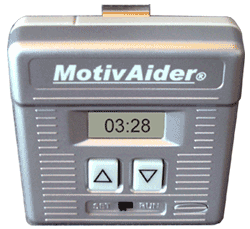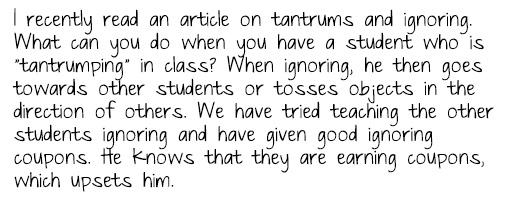Recently I began working with a family who has a six year old boy with autism named Austin (all names and identifying details have been changed to protect confidentiality). His mother was describing Austin’s behaviors when he couldn’t have something he wanted. She told me about him hitting his parents and younger brother, sweeping all materials off tables and shelves, and throwing himself on the floor. She was worried that he might hurt himself or hurt someone else. She told me that when he started this behavior, they would say, “Stop hitting.” They had been doing this for months, but his behavior had not improved.
 Later that week, she sent me a video of Austin having one of his “mega-tantrums.” It was exactly as she described, though there was one important detail she had missed. Austin consistently sought out eye contact and physical contact with both of his parents. If they were moving around to pick up an item, he would move his body and face to maintain eye contact. If one of them sat down, he would quickly clamber into their lap while screaming and pounding their arms or the furniture. If one parent walked out of the room, he would immediately run to the other parent. This behavior was clearly maintained by attention. In order to decrease the behavior, his parents had the very difficult task of ignoring it ahead of them.
Later that week, she sent me a video of Austin having one of his “mega-tantrums.” It was exactly as she described, though there was one important detail she had missed. Austin consistently sought out eye contact and physical contact with both of his parents. If they were moving around to pick up an item, he would move his body and face to maintain eye contact. If one of them sat down, he would quickly clamber into their lap while screaming and pounding their arms or the furniture. If one parent walked out of the room, he would immediately run to the other parent. This behavior was clearly maintained by attention. In order to decrease the behavior, his parents had the very difficult task of ignoring it ahead of them.
The next week I went out to their house to help them practice ignoring the behavior. We put in place a three-pronged plan:
- When Austin wanted something he was not allowed to have, he would be given a choice of options. The options should be for preferred activities. For example, if he wants to watch TV but isn’t allowed to right now, the parent can say, “Austin, you can play with trains or you can do a puzzle.”
- Once Austin starts hitting or screaming, he does not receive any attention. This includes eye contact, physical contact, and verbal prompts/reminders from his parents.
- The parents can start one of the motivating activities in another location. For this family, the parents sat with the younger brother at the dining room table and the mother read a book out loud.
As I had forewarned the parents, Austin’s behavior initially intensified as he realized he was getting zero attention. He took a box of toys, turned it upside down, and dumped it all over the floor. His mother kept reading to his brother. He ran over to his father and hit his legs while screaming, the father got up and walked away. Then, Austin did something he had never done before. He climbed up onto the table and started walking around on the edge of it.
His mother looked at me and said, “How do I avoid giving him attention for that?” This is when it’s important to consider high-quality attention and low-quality attention. In order to keep him safe, his mother needed to be more proximal. She walked near where he was on the table, but did not pick him up, did not make eye contact, and did not speak to him. (I let her know that if she felt he was very unsafe, she could pick him up and remove him from the table but quickly letting him go, and withholding eye contact and verbal interaction.) She stayed nearby to catch him if he fell, but she did not provide attention for this dangerous behavior. Her proximity (or if she had chosen to pick him up off the table without eye contact or verbal interaction) constitutes low-quality attention. High-quality attention is only saved for appropriate behavior.
Think about what high-quality attention means for a young child: big facial expressions, expressive tones of voice, big movements, and physical contact. Prior to our intervention, Austin was getting all of those types of high-quality attention for inappropriate behaviors. But now he wasn’t getting any of that type of attention.
However, Austin had been engaging in inappropriate behaviors for attention for 2-3 years now, so changing this behavior takes a little time. For our first day of the intervention, Austin continued to yell and throw items for 40 minutes before he finally went over to where his mom was sitting and reading aloud the story (actually, the third story in a row). When he was near and quiet, his mom started reading in a wonderfully expressive tone, adding voices to the characters. Austin came closer. When a funny part of the story happened, Austin laughed. And then Austin’s mother encouraged him and his brother to imitate the characters in another part of the story. After he imitated the characters, he sat next to his mom and she put her arm around him. All of these high-quality forms of attention were now being given for appropriate interaction.
Sometimes you have to provide some attention in order to keep a child safe, but think to yourself what is high-quality attention for your learner: it may be tickles, silly faces, expressive speaking, or physical contact. Reserve those things for appropriate behaviors.
A few final notes about this intervention: (1) Austin’s inappropriate behaviors will probably still continue for a little bit longer. I’m certain that he will test it out a few more times, and his parents will have to stick to the intervention in order to completely get rid of what they had deemed as “mega-tantrums”; (2) This intervention only works for behaviors maintained by attention. If you’re uncertain about the function of a behavior, confer with a BCBA or an ABA provider for help; and (3) If you’re not certain you can follow through if the behavior persists for a long time (such as 40 minutes in Austin’s case) then give in the first time the learner asks. For more information on this, look back at my tip on Choosing When to Battle.
 Pop Toobs – Set of 6
Pop Toobs – Set of 6 Ocean Wave Drum
Ocean Wave Drum

 The lids easily twist off and on, and the solid lids hold liquid securely inside. The tubes measure 12 inches in height and 2.5 inches in diameter. These Sensory Tubes will make your student’s reinforcement possibilities endless!
The lids easily twist off and on, and the solid lids hold liquid securely inside. The tubes measure 12 inches in height and 2.5 inches in diameter. These Sensory Tubes will make your student’s reinforcement possibilities endless!
 In this study, the researchers worked with a fifth grader with autism, a sixth grader with autism, and a fifth grader with cerebral palsy. They taught the boys to wear the MotivAider (calling it a pager) and note a + or a – to indicate their behavior each time the MotivAider vibrated. The behaviors they monitored were all related to being on-task: “eyes on my work,” “in my seat,” and “doing work.” Once each boy consistently rated his behavior upon feeling the vibration, the researchers implemented the intervention.
In this study, the researchers worked with a fifth grader with autism, a sixth grader with autism, and a fifth grader with cerebral palsy. They taught the boys to wear the MotivAider (calling it a pager) and note a + or a – to indicate their behavior each time the MotivAider vibrated. The behaviors they monitored were all related to being on-task: “eyes on my work,” “in my seat,” and “doing work.” Once each boy consistently rated his behavior upon feeling the vibration, the researchers implemented the intervention. The best way to improve socialization in children with autism is to emphasize play. There are several strategies to teach play skills to children on the spectrum that can help them improve socialization and develop friendships.
The best way to improve socialization in children with autism is to emphasize play. There are several strategies to teach play skills to children on the spectrum that can help them improve socialization and develop friendships.





 Later that week, she sent me a video of Austin having one of his “mega-tantrums.” It was exactly as she described, though there was one important detail she had missed. Austin consistently sought out eye contact and physical contact with both of his parents. If they were moving around to pick up an item, he would move his body and face to maintain eye contact. If one of them sat down, he would quickly clamber into their lap while screaming and pounding their arms or the furniture. If one parent walked out of the room, he would immediately run to the other parent. This behavior was clearly maintained by attention. In order to decrease the behavior, his parents had the very difficult task of ignoring it ahead of them.
Later that week, she sent me a video of Austin having one of his “mega-tantrums.” It was exactly as she described, though there was one important detail she had missed. Austin consistently sought out eye contact and physical contact with both of his parents. If they were moving around to pick up an item, he would move his body and face to maintain eye contact. If one of them sat down, he would quickly clamber into their lap while screaming and pounding their arms or the furniture. If one parent walked out of the room, he would immediately run to the other parent. This behavior was clearly maintained by attention. In order to decrease the behavior, his parents had the very difficult task of ignoring it ahead of them.